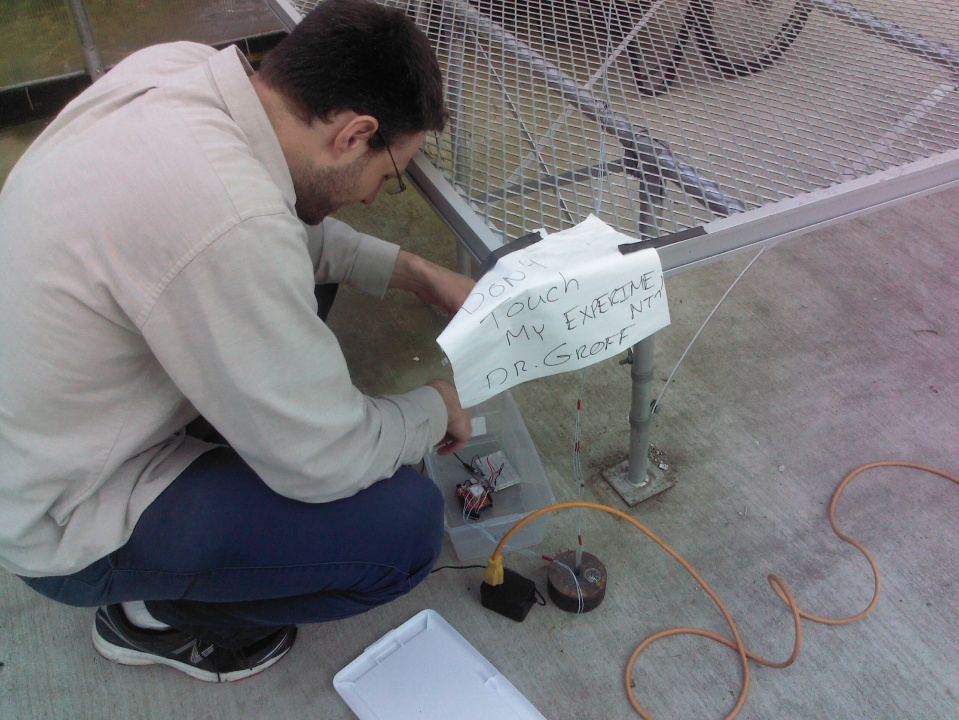Home » Shepherd University » Sustainable Greenhouse
Category Archives: Sustainable Greenhouse
Greenhouse Project
June 24, 2013 11:52 am / Leave a comment
As a SOARS Scholar and and intern at Shepherd University, I’ll be responsible for conducting research for presentation at both Shepherd University and the West Virginia Academy of Science. My focus will be on gaining some knowledge of the greenhouse under passive solar conditions in order to come up with physical model of the thermal properties of the greenhouse.
UPDATE: After much reading and thinking about our specific project, I have decided to address just the thermal mass of the cement floor to experiment on.
The greenhouse was built and designed to run as an active solar system, but utilizes passive solar techniques. The most important of these pieces is the concrete slab floor. The slab will act as a thermal mass regardless on weather the active system is pumping water through it so it is worthwhile to investigate the thermal properties of the slab.
For the purposes of this experiment, the sun will be the only factor in heating of the greenhouse, i.e. it will be passive only.
Measurements will be taken at 3 locations vertically inside the greenhouse and 1 taken outside the greenhouse. Factor – Height (m).
Measurements will also be taken of the solar irradiance inside the greenhouse. Factor – Solar Irradiance (W/m^2).
Here is the run down: Under what we will call “Normal” conditions, that is, with the greenhouse as is with concrete flooring, the floor collects solar energy, which means that while the greenhouse is warming up, it should warm up slower because of the thermal mass. If there were a thermal barrier on the floor, the greenhouse should warm up faster because the energy is not sinking into the floor. It is important to note that this condition does not compare to other greenhouse flooring materials, rather measures the magnitude of thermal capacity.
Under normal conditions, the greenhouse should cool down slower because the heat stored in the floor begins to radiate into the greenhouse as the greenhouse cools. With the thermal barrier condition, the greenhouse should cool off faster because no heat is stored in the floor.
It can be seen that the effect of the concrete floor should be to limit the variance in the change in temperature in the greenhouse.
It is important to remember that regardless of the condition, the slab has conductive transfer with the ground underneath it, assuming at around a constant 55 degrees F. I think the slab of our greenhouse has been insulated so this warrants testing of how well.
Also worth considering is how the greenhouse reacts to the timing of the covering of the greenhouse. if the greenhouse floor is insulated before the sun rises, the inside will heat up faster. If the cover were removed while still warming, the temperature inside the greenhouse should drop because there is no heat yet stored in the floor and the heat should sink there. In this case, the change in temperature should be equal to the amount of heat which can be stored in the floor.
This is important because ultimately the greenhouse will be an active solar system and we will know how much heat the floor can hold.
Alternatively, if the greenhouse floor were not covered in the morning and covered once the greenhouse was hot, the slab should hold the heat for a long time as it should not have large losses to the air above. This would be a great test to see how fast the heat is released into the ground below the greenhouse, ultimately giving us the effectiveness of the insulation there. Also, this should cause the greenhouse to warm slower and stay cooler because the heat is being trapped in the floor, this is a great way to keep temperature down during the summer.
If instead the area above plant level were covered, the barrier would act as a thermal blanket and let the floor to radiate into the greenhouse without loosing it into the outside air. This is a very common technique for a “passive” solar greenhouse for use in the winter.
WHEW!!! Well I have laid out 5 tests to be done and I feel good about this. It may be a good idea to set up a small scale experiment for proof of concept as well as making sure our system of data collection is in check.
Reference Materials
May 14, 2013 12:49 pm / Leave a comment
Here I am starting a list of scholarly and solid references to use for the purposes of writing my paper and presentation.
Greenhouses
- Thermography and Sonic Anemometry to Analyze Air Heaters in Mediterranean Greenhouses.
http://search.ebscohost.com/login.aspx?direct=true&db=a9h&AN=82913447&site=ehost-live - Thermal heating of controlled environment greenhouse: a transient analysis
http://www.sciencedirect.com/science/article/pii/S0196890499000953
Thermal Analysis
Micro-computing

